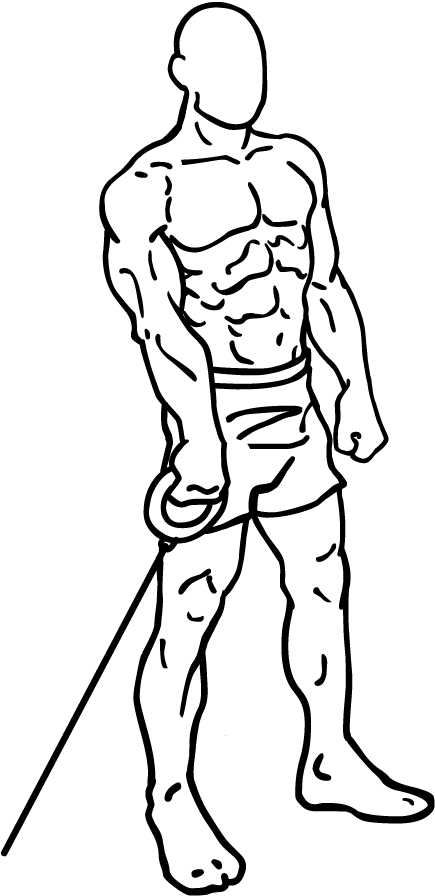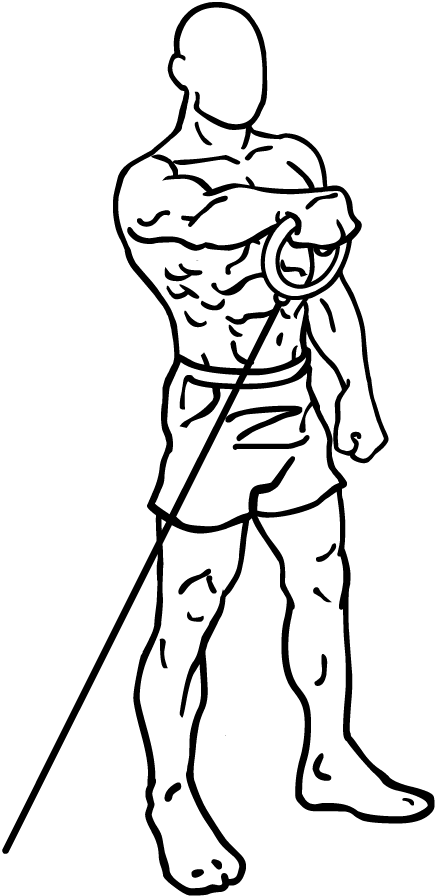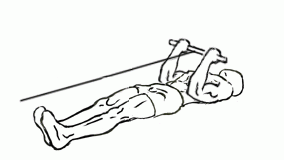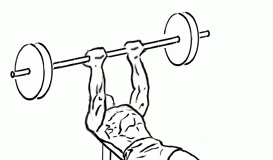Last Updated on September 30, 2014
If you’re looking to build well-defined shoulders, chest, and forearms, then front cable raises should definitely be part of your workout routine. This dynamic movement focuses on the anterior deltoids, chest, and forearms, offering a unique way to build upper body strength and improve stability. The front cable raise is particularly useful because it allows for a controlled range of motion, which engages stabilizing muscles and reduces the risk of injury, making it a great addition to any fitness program.
In this comprehensive guide, we’ll cover everything you need to know about front cable raises: how to perform them correctly, the muscles they target, the benefits they offer, and how you can make them a key part of your workout. We’ll also look into variations and progressions you can use to challenge your muscles in different ways, along with tips on avoiding common mistakes. By the end of this blog, you’ll not only understand the importance of this exercise but also be able to integrate it confidently into your routine.
Benefits of Front Cable Raises
The front cable raise is a versatile and effective exercise for a number of reasons. Here are some of the primary benefits:
- Strengthens Shoulders and Chest: The main muscle group targeted by front cable raises is the deltoids, specifically the anterior (front) deltoid. This exercise also engages your pectoral muscles, making it a great choice for upper body development.
- Improves Forearm and Grip Strength: Holding the cable with an overhand grip works your forearms, which contributes to better grip strength—an essential skill for other compound movements like deadlifts and pull-ups.
- Controlled Range of Motion: Using a cable machine allows for smooth, continuous tension throughout the movement. This helps you avoid the momentum that can occur when using free weights, allowing for better muscle isolation.
- Promotes Muscle Symmetry: Because this is typically a unilateral (one-sided) exercise, it helps correct muscle imbalances by ensuring both sides of your body work equally hard.
- Low Impact on Joints: Unlike free weights, where gravity plays a role, cables provide constant tension. This reduces the strain on your joints and makes the exercise more accessible for people with minor shoulder issues, as long as they do not experience pain while performing the movement.
- Improved Posture and Stability: Strengthening your shoulders, chest, and forearms contributes to better posture, particularly if you spend long hours sitting. This exercise promotes upper body stability and coordination, making everyday activities easier to perform.
Now that you understand the importance of this exercise, let’s dive into the correct way to perform front cable raises.
Step-by-Step Guide to Front Cable Raises
Performing the front cable raise correctly is essential for maximizing the benefits and minimizing the risk of injury. Here’s how you can do it:
1. Set Up the Pulley System
To start, you’ll need access to a cable machine. Begin by adjusting the pulley so that it is set just above the floor. This positioning will allow you to perform the movement with a full range of motion, from your waist to your shoulders.
Choose an appropriate weight for your fitness level. If you’re new to the exercise, it’s best to start with a lighter load to focus on mastering the form before increasing the weight.
2. Stand in the Proper Position
Position yourself in front of the cable machine. Stand with your feet shoulder-width apart, your knees slightly bent, and your core engaged. Drawing your abs in will provide stability and prevent unnecessary movement during the exercise.
Good posture is key for any strength training exercise, and this one is no different. Ensure that your back remains straight, your chest lifted, and your shoulders rolled back throughout the movement. Engaging your core is essential for keeping your spine aligned and preventing back strain.
3. Grip the Pulley Handle with an Overhand Grip
Grab the handle of the pulley with your left hand. Your palm should be facing the floor—this is known as an overhand grip. This grip will target the anterior deltoid and other muscles effectively, without placing undue strain on your wrists.
Make sure your arm is fully extended and your hand starts at waist height. This is your starting position for the movement.
4. Lift the Cable to Shoulder Height
From the starting position, slowly raise your left arm straight in front of you until your hand reaches shoulder height. Your arm should remain straight but not locked at the elbow. The movement should be controlled and smooth, with a focus on muscle engagement rather than speed.
As you lift, keep your wrist neutral—avoid bending or curling it. This ensures that your forearm muscles are actively engaged without overstraining your wrists.
5. Pause at the Top
Once your hand reaches shoulder height, pause for a moment. This brief hold allows you to fully engage the target muscles, particularly the anterior deltoid. Resist the urge to lift the cable above shoulder level, as doing so can place unnecessary strain on your shoulder joint.
The pause at the top also helps with muscle stabilization, as your body has to work harder to maintain the position before lowering the weight back down.
6. Lower the Cable with Control
After the pause, begin to slowly lower the cable back down to the starting position at your waist. The lowering phase should be just as controlled as the lifting phase. Don’t let the cable snap back into place—resist the weight on the way down to ensure your muscles remain engaged throughout the entire movement.
This eccentric (lowering) phase is just as important as the concentric (lifting) phase for muscle growth and strength gains. Take your time and focus on maintaining proper form as you lower the cable.
7. Switch to the Other Arm
Once you’ve completed the desired number of repetitions with your left arm, switch to your right arm and repeat the movement. By training each arm individually, you can ensure balanced muscle development and address any strength imbalances between your left and right sides.
For a full workout, aim to complete 3 to 4 sets of 8 to 12 repetitions per arm, depending on your fitness level and goals.
Tips for Proper Form and Maximizing Results
While front cable raises may seem straightforward, there are several key tips to keep in mind to ensure you perform the exercise correctly and get the most out of it:
- Engage Your Core: Keeping your abs drawn in is crucial for maintaining stability and preventing lower back strain. Your core acts as a stabilizer during this exercise, so don’t forget to engage it throughout the movement.
- Avoid Swinging or Using Momentum: One of the biggest mistakes people make with front cable raises is using momentum to lift the weight. Swinging your arm or your entire body to get the cable up takes the focus off your muscles and reduces the effectiveness of the exercise. Keep the movement controlled and deliberate.
- Don’t Lift Too High: Your hand should stop at shoulder height. Lifting the cable too high can place unnecessary strain on your shoulder joint and even involve muscles that aren’t meant to be targeted by this exercise.
- Maintain a Neutral Spine: Make sure to maintain a neutral spine by keeping your back straight and avoiding arching. If you find yourself leaning back or arching your back during the movement, it may be a sign that the weight is too heavy.
- Use Appropriate Weight: It’s always better to start with a lighter weight and increase as you get stronger. Using too much weight can compromise your form and increase the risk of injury, especially to the shoulder joints.
- Don’t Lock Your Elbow: Keep your arm straight throughout the movement, but avoid locking your elbow at the top of the lift. This will prevent joint strain and allow your muscles to do all the work.
- Pay Attention to Shoulder Pain: If you experience any shoulder pain during the exercise, stop immediately. Shoulder injuries can be serious, and it’s important not to push through the pain. Consult a fitness professional or a medical expert if pain persists.
Common Mistakes to Avoid
When performing front cable raises, it’s easy to make some common errors that can reduce the effectiveness of the exercise or lead to injury. Here are a few mistakes to watch out for:
- Leaning Back or Arching the Back: One of the most common mistakes is leaning back or arching your spine to compensate for the weight. This can place unnecessary stress on your lower back and compromise the safety of the movement. To avoid this, engage your core and keep your spine in a neutral position.
- Using Momentum: Some people use their whole body to lift the cable, which takes the focus away from the shoulders, chest, and forearms. The movement should be controlled and isolated to the target muscles. If you find yourself swinging, reduce the weight and focus on form.
- Lifting Too High: While it might seem like lifting the cable higher will work your muscles more, going above shoulder height can actually place strain on the wrong muscles and increase the risk of injury. Stick to raising the cable until your hand is at shoulder level.
- Not Controlling the Eccentric Phase: Letting the cable drop too quickly can reduce the effectiveness of the exercise and increase the risk of injury. Focus on controlling the weight both on the way up and on the way down.
Muscles Worked in Front Cable Raises
The front cable raise is primarily an isolation exercise for the deltoids, but it also engages several other muscle groups. Here’s a breakdown of the muscles worked:
- Anterior Deltoid (Front Shoulder): The anterior deltoid is the primary muscle targeted by front cable raises. This muscle is responsible for lifting your arm in front of you, and strengthening it can lead to broader, more defined shoulders.
- Pectoral Muscles (Chest): Although this exercise primarily targets the anterior deltoid, your pectoral muscles (chest) are also engaged during the lifting phase. The pectorals help stabilize your upper body as you raise the cable, and they work in tandem with the deltoids to complete the movement. Strengthening your chest muscles through exercises like front cable raises contributes to better upper body posture and symmetry.
- Forearms: Because you’re gripping the cable handle with an overhand grip, your forearm muscles are activated throughout the exercise. This helps build forearm strength and improves your grip, which can benefit you in other exercises that require a strong grip, such as deadlifts and rows.
- Core Muscles: Although the front cable raise primarily targets your upper body, your core plays an important stabilizing role. By engaging your abs and maintaining a strong, upright posture, you prevent your body from swaying or using momentum to lift the cable. This constant engagement helps strengthen your core muscles over time.
- Trapezius: The trapezius muscle, located between your shoulders and neck, also plays a minor role in front cable raises. It helps stabilize your shoulder joint as you lift and lower the cable, contributing to better overall shoulder health.
Variations and Progressions for Front Cable Raises
Once you’ve mastered the basic front cable raise, you can try incorporating some variations and progressions to keep your routine fresh and continue challenging your muscles. Here are a few options:
1. Single-Arm Front Cable Raise: If you want to increase the intensity and focus more on muscle imbalances, try performing the front cable raise with one arm at a time. This unilateral variation forces each arm to work independently, which can help correct strength imbalances between your left and right sides.
2. Seated Front Cable Raise: Performing the exercise in a seated position eliminates the ability to use momentum, making it harder for your deltoids to complete the movement. Sit on a bench with the cable pulley set just above the floor and perform the exercise as usual. This variation places even more emphasis on the anterior deltoid and core stabilization.
3. Front Cable Raise with a Plate: Instead of using a cable machine, you can perform a similar movement with a weight plate. Hold the plate with both hands in front of your waist, and raise it up to shoulder height using the same controlled motion. This variation works well for those who don’t have access to a cable machine but still want to target their shoulders and chest.
4. Isometric Hold Front Cable Raise: To add intensity and improve endurance, try incorporating an isometric hold at the top of the movement. Once your hand reaches shoulder height, hold the position for 5 to 10 seconds before lowering the cable. This variation increases time under tension and can lead to greater muscle activation.
5. Resistance Band Front Raise: If you don’t have access to a cable machine, you can perform a similar exercise using resistance bands. Attach the band to a low anchor point and follow the same steps as you would with the cable. Resistance bands provide constant tension and are a great alternative for home workouts.
Incorporating Front Cable Raises Into Your Routine
Front cable raises are a versatile exercise that can be easily incorporated into your existing workout routine. Here are a few ideas on how to include them:
- Upper Body Day: Since front cable raises primarily target the shoulders, chest, and forearms, they make a great addition to any upper body workout. Pair them with other shoulder and chest exercises, such as overhead presses, chest presses, and lateral raises, to create a comprehensive upper body routine.
- Push Day: If you follow a push-pull-leg (PPL) split, front cable raises are a perfect fit for your push day. This is when you focus on exercises that involve pushing movements, such as bench presses and shoulder presses. Add front cable raises towards the end of your push workout to isolate the deltoids after completing heavier compound lifts.
- Circuit Training: Front cable raises can also be used in circuit training to keep your heart rate up while building strength. Pair them with other upper body or core exercises, such as planks or push-ups, for a full-body workout that incorporates strength and cardio.
- Shoulder-Specific Workout: If you want to dedicate an entire workout to building bigger, stronger shoulders, front cable raises should be one of the key exercises in your routine. Combine them with exercises like lateral raises, bent-over rear delt flyes, and overhead shoulder presses to target all parts of the deltoid and achieve balanced shoulder development.
Progression Plan
To continuously challenge your muscles and see progress, it’s important to follow a progression plan for front cable raises. Here’s a simple guide you can use:
- Week 1-2: Start with 3 sets of 8-10 repetitions per arm using a light to moderate weight. Focus on perfecting your form and controlling the movement.
- Week 3-4: Increase the weight slightly while maintaining 3 sets of 8-10 repetitions. Add a brief pause at the top of the movement to enhance muscle engagement.
- Week 5-6: Progress to 4 sets of 10-12 repetitions per arm. You can also introduce variations like the single-arm or seated front cable raise to increase the challenge.
- Week 7-8: Increase the weight again, but lower the reps to 6-8 per set. Focus on slow, controlled movements and consider adding an isometric hold at the top of each rep.
By gradually increasing the weight and changing the intensity of the exercise, you’ll continue to challenge your muscles and avoid hitting a plateau.
Front cable raises are an excellent exercise for building strength and definition in your shoulders, chest, and forearms. Whether you’re new to strength training or a seasoned lifter, incorporating this exercise into your routine can lead to significant upper body improvements. The controlled, unilateral movement ensures muscle symmetry and stability, while the cable machine provides continuous tension that helps with muscle activation.
By following the step-by-step guide in this blog and avoiding common mistakes, you’ll be able to perform front cable raises with perfect form and maximize your results. Don’t forget to integrate variations and progressions as you get stronger to keep challenging your muscles and prevent plateaus. And always listen to your body—if you experience any discomfort or pain, adjust the weight or consult a fitness professional to ensure you’re performing the exercise safely.
Whether you’re aiming for strength, aesthetics, or improved posture, front cable raises should be a staple in your workout regimen. By making this exercise a regular part of your upper body routine, you’ll be on your way to stronger shoulders, a more defined chest, and improved overall upper body stability.








